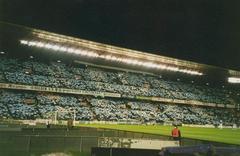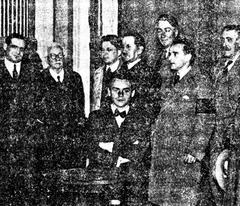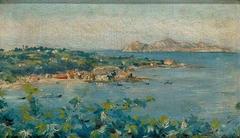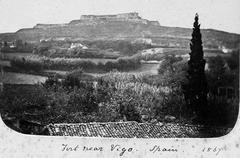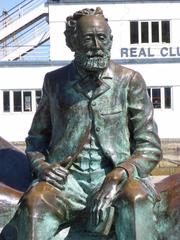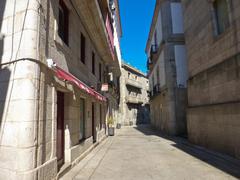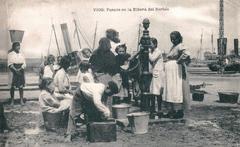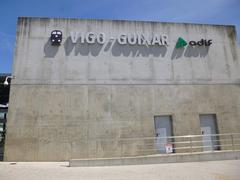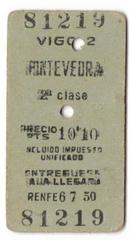Visiting the Monument to Work in Vigo, Spain: Complete Guide on Tickets, Hours, and Attractions
Date: 04/07/2025
Introduction: History and Significance of the Monument to Work
The Monumento ao Traballo (Monument to Work), locally known as “Os Redeiros” (“The Netters”), stands as one of Vigo’s most significant public sculptures and a cherished emblem of the city’s maritime and industrial heritage. Located at the start of Gran Vía, a bustling artery of Vigo, this dramatic bronze composition by Galician artist Ramón Conde captures seven fishermen straining together to pull in a heavy net—a powerful symbol of teamwork, perseverance, and solidarity.
Commissioned in the late 1980s and inaugurated in 1991, the monument pays homage to the generations of workers—fishermen, net-makers, and dockworkers—who transformed Vigo from a small fishing settlement into a major European port and industrial center. Beyond its artistic grandeur, the monument resonates deeply with Vigo’s social and political history, embodying the spirit of collective effort and community that continues to define the city.
Table of Contents
- Introduction
- Origins and Historical Context
- Design, Symbolism, and Artistic Process
- Socio-Political Significance
- Practical Information for Visitors
- Legacy and Influence
- Related Historical Sites in Vigo
- Frequently Asked Questions (FAQ)
- References and Further Reading
Origins and Historical Context
Vigo’s Industrial and Maritime Heritage
Vigo’s transformation during the 19th and 20th centuries into one of Spain’s leading industrial cities was driven by its thriving fishing, shipbuilding, and canning industries. The Monumento ao Traballo honors the collective labor of generations who propelled this growth, symbolizing the city’s deep ties to the sea and its reputation as Europe’s largest fishing port (Turismo de Vigo).
Commissioning and Artistic Genesis
Amidst late 20th-century economic changes, local authorities commissioned the monument to celebrate the pivotal role of Vigo’s working class. Ramón Conde, a renowned Galician sculptor, was selected for his ability to capture human struggle and resilience. His design—seven fishermen working in unison—draws on real-life observations and historic photographs to authentically represent the city’s laborers (Vigo en Fotos).
Design, Symbolism, and Artistic Process
The Monumento ao Traballo is an 8.5-meter (nearly 30-foot) bronze sculpture portraying seven life-sized fishermen in dynamic poses, united in hauling a massive fishing net. This physical and emotional realism, with detailed facial expressions and muscular tension, pays tribute to the arduous work of Vigo’s maritime community (Turismo de Vigo).
The net, emerging from a granite-clad fountain, symbolizes how the sea and labor are intertwined in the city’s identity. The heroic scale and composition elevate everyday workers to the level of civic heroes, reinforcing values of teamwork, resilience, and communal pride (Only By Land).
Socio-Political Significance
Installed during Spain’s democratic transition and integration with the European Union, the monument goes beyond artistic tribute. It reflects the aspirations and historical memory of the city’s working class, serving as both a civic icon and a backdrop for public events, labor commemorations, and annual festivals like the Reconquista (Facts.net).
Practical Information for Visitors
Visiting Hours and Accessibility
- Hours: Open to the public 24/7, year-round, as an outdoor sculpture.
- Entry Fee: Free access; no tickets required.
- Location: Intersection of Gran Vía and Rúa de Urzáiz, in Vigo’s commercial and financial heart (Concello de Vigo).
- Accessibility: The area is pedestrian-friendly and wheelchair-accessible, though Vigo’s hilly terrain may require extra care for visitors with mobility needs.
Getting There
- By Foot: Easily accessible from the city center, cruise port (about 15 minutes uphill), Old Town, and shopping districts.
- Public Transport: Multiple city bus lines (Vitrasa) serve nearby stops, including “Gran Vía – Urzáiz” and “Gran Vía – Venezuela.” For bus schedules, see Vitrasa website.
- By Car: Public parking garages such as “Parking Gran Vía” and “Parking Urzáiz” are nearby, though public transport or walking is often easier due to central traffic.
Guided Tours and Visitor Tips
- Tours: While there are no dedicated tours for the monument alone, it is a highlight of many historical and cultural walking tours of Vigo. Check with local tour providers or the tourist office for details (Discovering Vigo Walking Tours).
- Tips:
- Visit early morning or late afternoon for the best lighting and fewer crowds.
- Wear comfortable shoes as Vigo is hilly.
- The monument is well-lit at night, offering a different visual experience.
- Respect the site, especially during commemorative events or festivals.
Visitor Amenities
- Nearby Cafés and Restaurants: Gran Vía and adjacent streets offer ample dining options.
- Shops: Close to major commercial areas for shopping and souvenirs.
- Toilets: Available in nearby shopping centers.
- Green Spaces: Alameda Park and Avenidas gardens are within walking distance for relaxation.
Legacy and Influence
Since its unveiling, the Monumento ao Traballo has become a beloved city symbol and focal point for civic pride, regularly featured in local photography, educational programs, and public celebrations. It stands as a testament to the enduring spirit of Vigo’s workforce and continues to inspire similar tributes throughout Galicia and Spain (Wikipedia).
Related Historical Sites in Vigo
Enhance your visit by exploring other notable attractions in Vigo:
- Castro Fortress: Panoramic views and historical ruins.
- Museo do Mar de Galicia: Maritime museum exploring Galicia’s relationship with the sea.
- El Sireno Statue: Another striking city sculpture with mythological roots.
- Vigo Old Town (Casco Vello): Historic streets, tapas bars, and vibrant cultural life.
- Vigo Cathedral and Historic Port: Key sites reflecting the city’s architectural and seafaring heritage.
Frequently Asked Questions (FAQ)
Q: What are the visiting hours for the Monumento ao Traballo?
A: It is accessible 24 hours a day, year-round.
Q: Is there an entry fee or do I need tickets?
A: No, the monument is free and open to the public at all times.
Q: Are guided tours available?
A: Yes, many city walking tours include the monument. Inquire with local tour operators or the tourist office.
Q: Is the site accessible for wheelchair users?
A: Yes, the monument area is generally wheelchair accessible, though the uphill approach from the port may require assistance.
Q: What other attractions are nearby?
A: The Old Town, Castro Fortress, Museo do Mar de Galicia, El Sireno statue, and numerous cafes and shops.
Q: Are there public restrooms nearby?
A: Yes, public toilets are available in nearby shopping centers.
Visitor Tips
- Wear comfortable shoes due to the city’s hilly terrain.
- Combine your visit with nearby historical sites for a full experience.
- Consider public transport or taxis for easier access.
- Bring a camera—morning and late afternoon light are best for photography.
Visuals and Media
For photos, virtual tours, and more information, visit the official tourism and cultural websites:
Summary and Final Tips
The Monumento ao Traballo offers a striking blend of artistic achievement and historical resonance, celebrating the resilience and unity of Vigo’s people. Free and open around the clock, it’s a must-see for any visitor seeking to understand the city’s spirit. Take time to appreciate its details, reflect on its meaning, and explore the rich cultural landscape that surrounds it.
Enhance your visit with tools like the Audiala app for guided tours and up-to-date insights. Stay connected via local tourism platforms and social media for the latest on Vigo’s cultural events and attractions.
References and Further Reading
- Turismo de Vigo - Monumento ao Traballo
- Turismo de Vigo - Monumento al Trabajo (English)
- Concello de Vigo - Official City Site
- Wikipedia - Monumento ao traballo
- Facts.net - Vigo City Facts
- Only By Land - Things to Do in Vigo
- Vigo en Fotos - Ramón Conde Sculptures
- Discovering Vigo - Things to Do in Vigo
- Discovering Vigo - Cruise Port Guide
- Minube - Monument to Work
